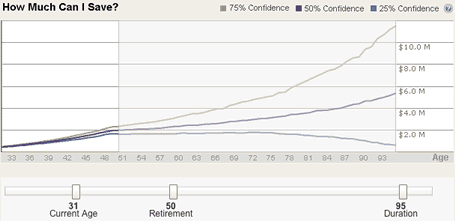As far as retirement calculators go, the new one over at the Scottrade Knowledge Center is pretty nice. It does the whole Monte Carlo thing, running theoretical scenarios based on historical data. There are fancy interactive sliders that let you input your current portfolio balances, annual contributions, and your future expenses. The result is a pretty chart:

But the same problem always occurs whenever retirements depend heavily on market returns. If future returns are on the low side of history, I could end up broke* and eating dog food by age 90. If future market returns are high, then I could die with $10 million in the bank. What the heck do I need with that much money at age 90?
One way to avoid this is to have a very conservative portfolio of safe and short-term bonds (or TIPS). This has the slight inconvenient problem of requiring a very high savings rate. (Or lottery winnings, a large inheritance, or other windfall.)
Now, it would be nice to have a way to share the risk with others out over longer periods of time. Give up some of the potential upside, in return for some downside protection. This usually involves an insurance company (annuities) or the government (Social Security). Which do you want to trust with a big chunk of your hard-earned money? It’s a tough call. 🙂
* This isn’t technically true. I’m sure in reality, if my portfolio was doing so poorly, I would adjust my spending however I could. But I would have to decrease my standard of living.
 The Best Credit Card Bonus Offers – 2025
The Best Credit Card Bonus Offers – 2025 Big List of Free Stocks from Brokerage Apps
Big List of Free Stocks from Brokerage Apps Best Interest Rates on Cash - 2025
Best Interest Rates on Cash - 2025 Free Credit Scores x 3 + Free Credit Monitoring
Free Credit Scores x 3 + Free Credit Monitoring Best No Fee 0% APR Balance Transfer Offers
Best No Fee 0% APR Balance Transfer Offers Little-Known Cellular Data Plans That Can Save Big Money
Little-Known Cellular Data Plans That Can Save Big Money How To Haggle Your Cable or Direct TV Bill
How To Haggle Your Cable or Direct TV Bill Big List of Free Consumer Data Reports (Credit, Rent, Work)
Big List of Free Consumer Data Reports (Credit, Rent, Work)
Isn’t what you’re asking for basically hedging? One way you could do this is buying puts on instruments such as SPY or QQQQ. That would effectively hedge you in case the market dies, but would also limit your upside in the case that the market goes up.
You ask “Which do you want to trust with a big chunk of your hard-earned money?”
Personally, I want to trust several different, historically-reliable entities with my money and – even then – assume a loss rate.
Yep, pretty chart. But the whole exercise is near-meaningless for a married couple – the “Tax Deferred” slider only goes up to $20,000. If a married couple maxes out their respective 401k contributions, that’s $33,000. Even maxing out the “Tax Free” slider only brings you to a total of $35,000 – the max for a married couple is $43,000 (33k + 10k).
FireCalc is still the better one, IMO.
Very cool calculator – thanks for posting this!
I do wish their tax-deferred slider went higher. $20k isn’t enough. People maxing out a traditional IRA and a 401(k) currently can’t input their correct annual contribution. In my case, I have a 401(a) as well as a 457 totaling close to $25k a year – so I have to input a tax-deferred number 20% off.
By the way, I’m assuming you listed your portfolio as “aggressive” to get such a wide distribution of returns. My portfolio is very similar to yours (as shown on the blog), and I put “moderate” and it yielded a narrower range from $2 mil to $8 mil.
My thinking is it’s 70/30 equities/bonds now, but by the time I retire it will be 40/60, and pretty much over that time period for my age I’m relatively moderately allocated. A lot of people are way more aggressive than that.
Personally, I think these kinds of calculators don’t take into account the real world.
No one in retirement would blindly increase their spending each year and never consider their over-all portfolio value. In the real world, if someone’s portfolio takes a big hit, they would look for ways to decrease spending, or if their portfolio had a big increase they would often increase spending at a greater rate.
I’d like to see a retirement withdrawal strategy that is a little more intelligent and a little more realistic than “increase spending each year by inflation”.
@Jack – You could probably do that, but it seems like it would be a lot of continuous work. I’ve seen experts propose LEAPS + some sort of bond I think.
@Ben – I actually agree, and I would stay under your state’s guaranty limits:
https://www.mymoneyblog.com/creating-lifetime-income-via-aarp-immediate-annuity.html
@JimB – I ran into the same thing, I wonder why they didn’t account for that. Firecalc is a great tool.
@Dan – Actually, I put moderate. I only put in general number, but my main problem is that I have only 19 years of saving and 45 years of spending. If I retire any earlier, the 25% confidence line actually does hit zero!